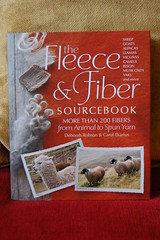First, the facts:
Title: The Fleece and Fiber Sourcebook: More Than 200 Fibers, from Animal to Spun Yarn
Author: Deborah Robson and Carol Ekarius
Published by: Storey Publishing, 2011
Pages: 448
Type: Reference.
Chapters:
1. Fiber Fascination
2. Sheep: Ooodles and Boodles of Wool
3. Other Species: The Rest of the Menagerie
The In-Depth Look:
When you pick this book up in your hands, the first think you’ll realize is this is a substantial piece of work.
I mean that literally. At 448 pages and weighing something like four pounds, this is a hefty book. Which, if you’ve been working on a book for years, is exactly the kind of book you want to show.
Because, this book is amazing. I thought I was pretty familiar with most of the better-known sheep breeds roaming about this planet of ours, but … apparently not. In fact, I seem to know just the tiniest bit more than your average shopper at Target who sees “100% wool” in a sweater tag and never wonders what KIND of wool. There are so many breeds I’ve never heard of!
Deb Robson and Carol Ekarius, though? They know everything. They’re goddesses.
This book–a true sourcebook–is like the Who’s Who of the sheep world. It’s exhaustive and chock-full of huge amounts of research. This not only includes the list of over 200 different breeds, families, groups (along with non-sheep species), but … Photos! Stories! Songs! Legends! Charts! Maps! If there’s a story behind a breed, pertinent facts about the geography, a farmer who dedicated his life to raising them, a legend about their origin, it’s in here.
And did I mention the photos? Oh, the photos! Not only pictures of the sheep (in the fields as well as properly posed “show” pics), but of the fleece–both clean and raw–yarn spun from it, swatches knitted and woven from it. So many beautiful photos. This book is full of true eye candy for a sheep lover.
It’s not just sheep, either, though they take up about 300 of the pages. The authors take the time to visit with other fiber-bearing animals, too, from goats to camels to rabbits, dogs, llama, yak, and even horses.
I was prepared to be impressed by this book. Just knowing the amount of work that went into it, I was ready to like it. (How much work? Just for starters, the bibliography is five pages long. The index ix nine pages.) But “like” is too mild a word. I was floored by how exceptional this book is. It puts my old copy of “In Sheep’s Clothing” to shame. Even Clara Parkes’ Book of Wool can’t compare, if only because it used valuable pages for patterns instead of focusing solely on the animals.
Because it’s true–there are no patterns in this book. There are no instructions on spinning. No step-by-step guides on how to prepare a fleece for spinning. There are plenty of books that do those things. But this? This is a love letter to sheep, to wool, and to the history of human beings and natural fiber.
You often hear about books or movies being described as a “labor of love,” and I have no doubt in my mind that that is exactly what this book is. The sheer fascination and appreciation of all these many fibers and animals … the honor for the people over the centuries who have devoted themselves to their breeds and their craft … the appreciation saturates every page.
As they say, “[Synthetic fibers] don’t connect us to the earth. They aren’t sustainable. Natural fibers are part of our culture, our heritage. They have stories. They have a living, breathing animal (or a growing plant) behind them. They often have small-scale farmers or indigenous communities behind them, too–people and cultures whose livelihoods and historic identities can be supported by their continuing work with these fibers.”
Trust me, you’re going to want this book. You’re going to find yourself poring over the pictures and fondling the pages, just like you finger your yarn and your spinning fibers. And you’ll never look at a label that says “100% wool” in the same way again.
This impressive book is available at Amazon.com.
Want to see bigger pictures? Click here.

This review copy was kindly donated by Storey Publishing. Thank you!


Comments on this entry are closed.
There aren’t words to describe how important this book is but you have done a credible job. This book is especially outstanding because it is pure reference with no extraneous how-tos, patterns or other distractions to fill the pages!!
Pam, thank you so much for saying so! It’s an awesome (and pretty) book with tons amount of information–what’s not to like? (grin)
I had the pleasure of witnessing this book take shape over the last 4 years and it was awe-inspiring. I’m so glad everyone is recognizing the value of such a massive volume!
Wow! What a book! I checked it out of the library and renewed it as many times as I could (5 times!) before I broke down and
ordered it from KnitPicks while it was on sale. It is so informative. I found myself reading lots of parts as if it were a novel.
I was ooooing and ahhhing and smiling over the pictures. Loved the snippets of info about each fiber and what it will be especially
suited for: i.e., the downs fibers from the Downs ‘category’ of sheep (Dorset Down, Oxford, etc.) often make excellent sock yarns – who knew!!